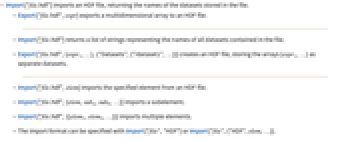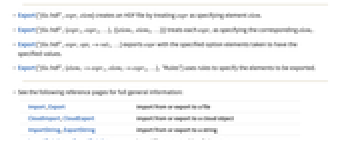HDF (.hdf)
Background & Context

-
- MIME type: application/x-hdf
- HDF data format Version 4.
- General-purpose format for representing multidimensional datasets.
- Used for storage, management, and exchange of scientific data.
- HDF is an acronym for Hierarchical Data Format.
- Developed by the US National Center for Supercomputing Applications (NCSA).
- Binary file format.
- Incompatible with HDF Version 5.
Import & Export

- Import["file.hdf"] imports an HDF file, returning the names of the datasets stored in the file.
- Export["file.hdf",expr] exports a multidimensional array to an HDF file.
- Import["file.hdf"] returns a list of strings representing the names of all datasets contained in the file.
- Export["file.hdf",{expr1,…},{"Datasets",{"/dataset1",…}}] creates an HDF file, storing the arrays {expr1,…} as separate datasets.
- Import["file.hdf",elem] imports the specified element from an HDF file.
- Import["file.hdf",{elem,suba,subb,…}] imports a subelement.
- Import["file.hdf",{{elem1,elem2,…}}] imports multiple elements.
- The import format can be specified with Import["file","HDF"] or Import["file",{"HDF",elem,…}].
- Export["file.hdf",expr,elem] creates an HDF file by treating expr as specifying element elem.
- Export["file.hdf",{expr1,expr2,…},{{elem1,elem2,…}}] treats each expri as specifying the corresponding elemi.
- Export["file.hdf",expr,opt1->val1,…] exports expr with the specified option elements taken to have the specified values.
- Export["file.hdf",{elem1->expr1,elem2->expr2,…},"Rules"] uses rules to specify the elements to be exported.
- See the following reference pages for full general information:
-
Import, Export import from or export to a file CloudImport, CloudExport import from or export to a cloud object ImportString, ExportString import from or export to a string ImportByteArray, ExportByteArray import from or export to a byte array
Import Elements

- General Import elements:
-
"Elements" list of elements and options available in this file "Summary" summary of the file "Rules" list of rules for all available elements - Data representation elements:
-
"Data" all datasets imported as a list of arrays "Datasets" names of all datasets - Import by default uses the "Datasets" element for the HDF format.
- Specifying and selecting datasets:
-
"Datasets",n n  dataset
dataset"Datasets",dataset named dataset - Meta-information elements:
-
"DataFormat" type used to represent each dataset "Dimensions" data dimensions of each dataset - The following values can be given for "DataFormat":
-
"Integer8" 8-bit integers "Integer16" 16-bit integers "Integer32" 32-bit integers "UnsignedInteger8" 8-bit unsigned integers "UnsignedInteger16" 16-bit unsigned integers "UnsignedInteger32" 32-bit unsigned integers "Real32" IEEE single-precision numbers "Real64" IEEE double-precision numbers
Examples
Basic Examples (2)
Show the names of datasets in a file:
Import a dataset and render it as a raster image:
Render as ArrayPlot, specifying a color scheme:
Rasterize the color image and export the data to HDF:
Create a random matrix and export it to HDF:
History
Introduced in 2004 (5.1) | Updated in 2007 (6.0)